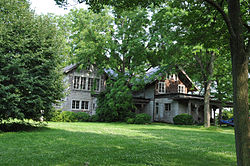Linwood (York, New York)
|
Linwood
|
|
 |
|
| Location | 1912 York Rd., York, New York, U.S. |
|---|---|
| Coordinates | 42°51′59″N 77°56′16″W / 42.86639°N 77.93778°WCoordinates: 42°51′59″N 77°56′16″W / 42.86639°N 77.93778°W |
| Area | 350 acres (140 ha) |
| Built | 1899 |
| Architect | multiple |
| Architectural style | Romanesque |
| NRHP Reference # | 97001493 |
| Added to NRHP | December 15, 1997 |
Linwood Gardens (also known as the Gratwick Estate) is an historic estate and national historic district located at York, New York in Livingston County, New York. The estate is a 350-acre (1.4 km2) property centered around a summer house and surrounded by developed garden areas, woods, and meadows. Most notably, it is home to an historic collection of tree peonies collected and developed by William H. Gratwick III and Nassos Daphnis in about the 1940s-1960s.
Linwood Gardens was listed on the National Register of Historic Places in 1997.
William Henry Gratwick, Sr. (1839-1899), was born in Albany and moved to Buffalo, NY in 1877 to found the lumber business Gratwick, White and Fryer Lumber Company, with offices in Tonawanda, Buffalo, and Detroit. The company owned timberland in Michigan and six ships to transport the timber on the Great Lakes. The Gratwick family lived at 776 Delaware Avenue in Buffalo in architect Henry Hobson Richardson's last commissioned home, an imposing brownstone, which stood until 1919. William succumbed to colon cancer in 1899, but notably was treated by Dr. Roswell Park of Buffalo during his illness. Mrs. Martha Weare Gratwick, William's widow, donated $25,000 to Dr. Park which assisted in the establishment of the Roswell Park Cancer Institute, the first institution in the world to focus solely on cancer research. The remaining fortune earned by William was split among his three children, including his son, William H. Gratwick, Jr.
When his father passed away, "Harry" assisted in management of the lumber company but preferred other pursuits, including real estate projects in the Midwest and acting as Vice-President of the New York State Board of Charities. With the inheritance he also scouted out a farm property in Livingston County, New York, which proved suitable for the establishment of a summer estate, which was a popular investment for those of means. The property was purchased in 1900 and construction began shortly after. Harry worked with Green and Wicks, a prominent Buffalo firm, to design the summer house, and hired Boston landscape architect Thomas Fox to plan out the surrounding roads and garden areas between about 1901-1910. The results still stand today, with some alterations. The gardens were recognized with the Historic Landscape Award from the Landmark Society of Western New York in 2015.
...
Wikipedia


